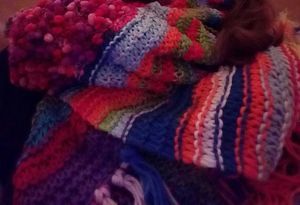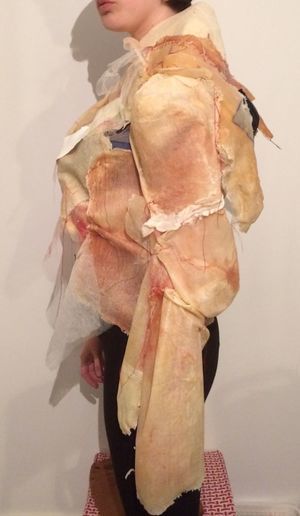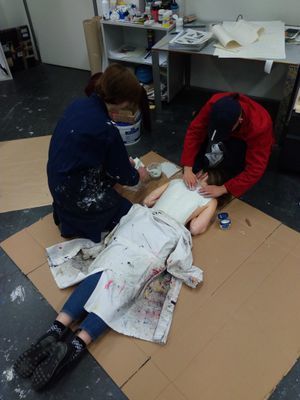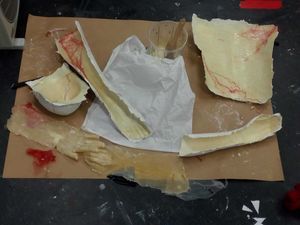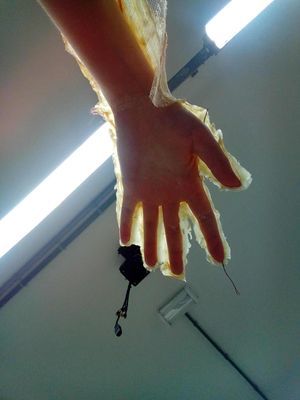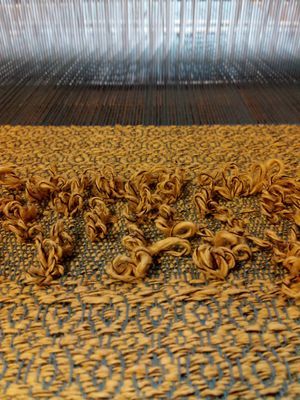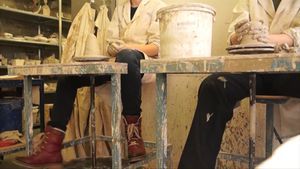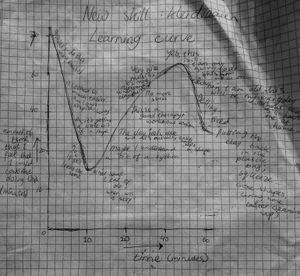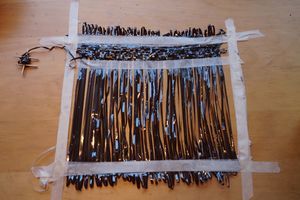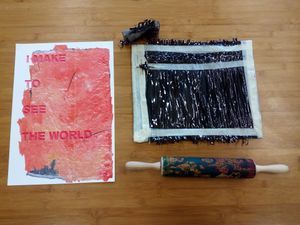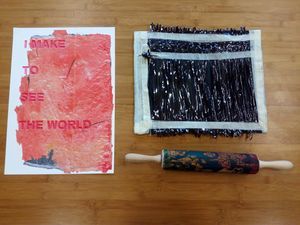Difference between revisions of "User:0904492"
| Line 13: | Line 13: | ||
==== Politics of work and craft - Introducing two pioneers: Ruskin and Morris ==== | ==== Politics of work and craft - Introducing two pioneers: Ruskin and Morris ==== | ||
| − | [[File:T220-CS-wool-history-1.jpg|thumb|A picture of a stained glass window in Notre Dame of Semur-en-Auxois showing the wool history; a | + | [[File:T220-CS-wool-history-1.jpg|thumb|A picture of a stained glass window in Notre Dame of Semur-en-Auxois showing the wool history; a Medieval guild <ref>Burgundy, Drapers' guild of. (dedicated to St. Blaise). Notre Dame. A Window on Wool History. Semur-en-Auxois, 1460-1470. Stained glass window. Image.</ref>]] |
The discussion about craft took shape in the UK during the 19th century. Originally, craft meant something like “sly trickery”, but later on it was used to describe “manual art”, up to a point where it also meant “ability”. “Craft” took roughly three paths since the Industrial Revolution: decorative applied forms of creativity that are generally less valued than “fine art”, something handmade that’s associated with authenticity (of a community) and the condition in which someone works that becomes a priority over the finished product (politics of work). The third one strikes most with the message of Ruskin and Morris. | The discussion about craft took shape in the UK during the 19th century. Originally, craft meant something like “sly trickery”, but later on it was used to describe “manual art”, up to a point where it also meant “ability”. “Craft” took roughly three paths since the Industrial Revolution: decorative applied forms of creativity that are generally less valued than “fine art”, something handmade that’s associated with authenticity (of a community) and the condition in which someone works that becomes a priority over the finished product (politics of work). The third one strikes most with the message of Ruskin and Morris. | ||
Revision as of 12:15, 21 March 2023
Contents
- 1 Research
- 1.1 Theory
- 1.1.1 Politics of work and craft - Introducing two pioneers: Ruskin and Morris
- 1.1.2 Influence of Ruskin and Morris throughout history: Arts and Crafts movement, DIY movement and craftivism
- 1.1.3 Critique on the word “craft”
- 1.1.4 The battle of art and craft
- 1.1.5 Walter Gropius: Bauhaus Manifesto
- 1.1.6 Added notes from the 21st century about craft
- 1.1.7 Wrapping
- 1.1.8 The history of wrapping and knitting
- 1.1 Theory
- 2 Studio practice
Research
Theory
In the practice digital craft we started by reading about different definitions of “craft”. It turned out to be a loaded term, the meaning of which depends on the place and person. The usual status of craft is sadly rather one of low value, because there’s the idea that it would lack intellectual creativity. Craft is mostly seen as the human activity of making objects for themselves and others in the offline, non-digital world ([1]).
Politics of work and craft - Introducing two pioneers: Ruskin and Morris
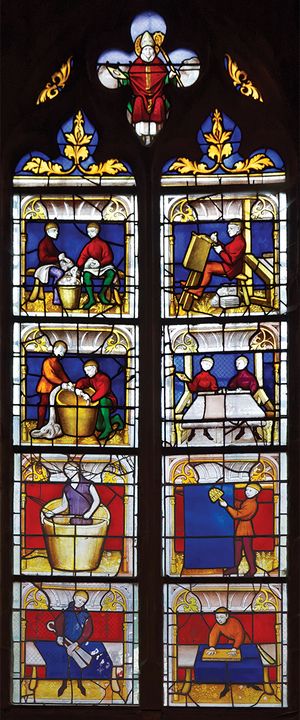
The discussion about craft took shape in the UK during the 19th century. Originally, craft meant something like “sly trickery”, but later on it was used to describe “manual art”, up to a point where it also meant “ability”. “Craft” took roughly three paths since the Industrial Revolution: decorative applied forms of creativity that are generally less valued than “fine art”, something handmade that’s associated with authenticity (of a community) and the condition in which someone works that becomes a priority over the finished product (politics of work). The third one strikes most with the message of Ruskin and Morris.
The Industrial Revolution brought with it philosophical and political protests about working circumstances. John Ruskin, Karl Marx and later William Morris provided their impactful perspectives. Ruskin (1819-1900, born in London) was an aquarellist, art critic and writer, who engaged in conservative politics with an emphasis on the value of community, the value of local organic production and on the care for all workers. Marx (1818-1883, born in Trier) was a master economist and philosopher, who wrote The Communist Manifesto together with Friedrich Engels. Morris (1834-1896, born in Walthamstow, UK) was an artist and entrepreneur, whose socialism is inspired by Ruskin. He aspired to create an art community in which people could enjoy making beautiful objects for everyday life.
In factory work in a capitalist society like the UK in the 19th century, there was a separation between the thinking and making parts. The thinking part decides what others will make and divides the tasks in segments; the makers have become operators. To demand of a person to operate and follow rules exactly, without any personal freedom, is to make one a tool. Ruskin fears the loss of creative and moral spirits: he focuses mainly on the importance of embracing one's creativity in a working environment, which would ideally be freely expressed and individual. A worker should be allowed to produce a whole thing. Ruskin seems to long back to the Middle Ages with their craft in the Labor Parties, because of the ornamentations that showed individual quirks and talents. For Marx this division of labor means a form of slavery, which he uses as an argument against capitalism in his manifesto. A lot of people have a terrible job and feel alienated from it, which leads to products of low quality. The “producers” (thinkers) are disconnected from the making process as well as the operators. Morris practices many kinds of art to produce beautiful everyday objects. He shows that if a person feels in the process that he has the power to leave a creative mark, it will empower the process and usually make an eventual product very beautiful in use and aesthetically: this feeling is the “joy de faire” (joy of making). Though he wishes to inspire many people around him already by letting them experience the beauty of craft, his products are quite exclusive and luxurious due to the fine materials and precise handicraft.
A true making process connects the intellectual with the physical work. Separating ideas from knowledge of how things are made cannot lead to creativity within the making process. When people can add their individual value in a collaboration, then there can exist a healthy community: a community (and hopefully society) that treasures living beings instead of exploiting them. Making things from natural materials is vital for us. The process gives us new ideas that have an influence on our daily life. The three of them redefine wealth: wealth is about core values, like creativity and nature instead of “growth” or “innovation”. Growth and innovation seem empty and cost people more than they’re supposed to generate. Morris already even made a note that innovation should be used to take care of the environment.
In his book “The Revival of Handicraft” Morris’ vision about industrial production becomes even more clear: Putting responsibility of production on fewer minds is a way of diminishing general intellect. Though some intellectuals may strive for some form of perfection and look upon machines as perfect executers for their ideas, in return people will forgot what a beautiful object is, actually, next to the handicraft techniques (with the joy de faire). They need material objects and so they will take what they get. After some time they will be used to the standards of this industrial production, while the standards of that production are only a vague middle of the consumers’ wishes. Besides, what will people have to do with all this time, when their handicraft doesn’t seem essential anymore? What will ugly products do for unproductive people? It is desirable is that mechanization will play a dynamic role in some revival of handicraft instead of creating an industry that doesn’t need humans and isn’t for real humans anymore ([3]).
Influence of Ruskin and Morris throughout history: Arts and Crafts movement, DIY movement and craftivism
Ruskin’s and Morris’ ideas about work ethos seeped on to DIY culture in the 20th century via the Arts and Crafts movement. The Arts and Crafts movement was blossoming from 1887 till the First World War. This movement aimed to equally value all creative work, because creative workers contribute to a vibrant and dynamic culture by their individual share in production. Making things by hand allows one to connect with nature, a sense of self and other people. Since craft expresses individual life it cannot be taken over by machines with steps nor be divided in a too repetitive method. This vision enabled the Arts and Crafts movement to strongly combine theory and practice with its ideal of “liberation of humankind by communal creativity”. The uniting of work processes with the demand of higher quality of life linked the status of “craft” to the meaning of “power” ([4]).
The arts and crafts movement led to unaffordable products for the typical worker, about whom the movement claimed to be concerned. The high prices of those products were unintended, but the outcome of the time consuming care and materials that went into the products. This paradox led to popularity of DIY culture, into which a democratic element is added by the phrase: “Do it yourself.” This way people don’t have to await a solving of the political system from outside, while their circumstances were actually becoming harder by the rise of prices. Gustav Stickley (1858-1942, born in Osceola, US) was a big pioneer of DIY culture in the UK, because he published his magazine as an open source for knowledge of crafts despite the possible consequences on his own financial situation. The DIY culture was nurtured by a lot of different people: from homeschooling parents, to punkers, to environmentalists and entrepreneurs.
DIY culture in the 1960’s had more to do with a counterculture that refused the content that educational institutions taught children than with today’s associations. Parents and very creative people were concerned that schools did not teach kids any essential elements of life, but rather abstract phenomena that could only prepare kids to become part of a bureaucratic web etc. (Alan Watt, philosopher, phrased these ideas quite well back then.) There was a big home-schooling movement that claimed that adults should give children the freedom to pick their own learning topics and that they should trust that children could build their own meaningful connections with knowledge. Stewart Brand launched the Whole Earth catalogue in 1968, which offered people a lot of practical DIY information for everyday-life. He was quite an environmentalist (like the Arts and Crafts movement) with his ideals actually. Brand thought that people should see the created picture of the whole earth, to become aware of their own position on earth with limited sources. A person should take up responsibility for the care of the environment and value the connections with it.
Even though there is the internet, handmade objects remain an important medium to spread the DIY culture. While the internet is a very innovative and quite effective medium, it lacks the tactility of a handmade, physical object for the bonding with it. It also lacks the learning experience of making something yourself instead of just looking at someone else making things. So if “laziness” is an outcome of available information about making processes, then that would be a pity. The internet is much more effective for distributing a subject than via objects. If it isn’t necessary to use sources of from nature to produce a product, it would be better for the environment not to produces objects then. Objects (like zines), on the other hand, feel more substantial; they seem to have more weight as a replacement of main stream culture, which makes them suitable for a variety of topics. The DIY movement has this ethos about anti-consumerism that clashes with the main stream culture: DIY’ers reject the idea that you can pay other people for a solution to all imaginable problems. DIY is more like an attitude than an activity.
In 2003 Betsy Greer even combined the words “craft” and “activism” in the word “craftivism”. Craftivism describes the political choice of resistance made by making things yourself instead of just buying them somewhere. Making things yourself is good for your self-esteem instead of disempowering and you can add a personal side to your objects. It is interesting to see how craftivism can spread a pro-active, positive message, where people usually try “stop that”. Since craft has such a personal influence and representative power, it has the capacity to bring across a rather striking message and it gives people the opportunity to join such a movement. With environmentalism and sustainability (which has to do with autonomy, mobility and social patterns) the fact that the practical part actually binds people with the protected materials enhances the other bright sides of craft. It is easy not to feel responsible for Wicked Problems, it becomes harder when you get to feel more connected with the environment.
The spirit of craft can also become visible in other ways than a direct physical manifestation. To help create sustainable social patterns, craft can be redefined as daily human behavior that we practice with each other on a daily base. So everybody is crafting already and we are the material, but we can become more aware of that fact and how we make a difference thus. We can start crafting gentleness with friendlier values than the harsh “right” or “wrong”, that put some people in a bright spot an others in the dark. Values like “helpfulness” and “appropriateness” might help. The power patterns can change. The society doesn’t have to look like a closed, unliving system in this way. Craft doesn’t have to mean hands on, but it occupies all interactions with nature (including people).
Critique on the word “craft”
When Ruskin and Morris were discussing “craft” in the 19th century, “craft” already had a conservative reputation. If craft is fundamentally the opposite of the processes of modernization, then handwork could only have a small impact on society within a capitalist economy. People still believed that craft could have multiple functions though: craft could function as a retreat (a withdrawal from modernity), craft could soften the hard edges of the modern daily life or craft could take a role like fine art. The following could be corrected or used a footnote by Ruskin’s and Morris’ texts: apparently there were more artisans in 1850 than in 1750 actually; “labor aristocracy” happened already in the Medieval Ages, when highly trained craftspeople defended their privileged position in the Medieval Ages; the new mechanical tools from the Industrial Revolution enriched a lot of production processes that still entailed handicraft and the making of industrial tools and machines depended on craft.
The term “craft” was invented halfway the 18th century already as an attempt to position the power of hand skill as a supplementary one, because from then on it seemed possible to categorize craft. Actually it was common knowledge back then that artisans could practice a powerful form of control. Halfway the 18th century a shift took place in artisanal workshops: the division and specialization of labor, so that the executer would start to be seen as “generic”. Craft gained the meaning of only a possible part of a production process. In other words: the division of labor started before the Industrial Revolution and actually had to do with the mystical power of hand skill.
Some tractable materials like cast iron, papier-mâché and rubbers were seen as so plastic, that people have believed for a period that designers could model them with their mind. Inexplicable things (like craft or magic) used to hold great cultural status. Now people are afraid of them and want something that they think they can control with words. Writing about craft was used by Victorians as an attempt to diminish the control that craft had. Fortunately for craft, it is very difficult to “explain” craft and undo its “manipulative structures”. The amount of publishing of craft in the 19th century far transcended the utility. Instead of artisan’s endeavor for “mystery”, somehow there became one for a “self-serving form of explicit description”.
Before the industrial revolution and outside of Europe and America, one could not even speak of craft as a separate field. Any serial production needed a lot of hands. Since the term is quite new and from Europe and America, the term might suggest that before the second half of the 18th century and outside of Europe and America there haven’t been stories of transformations within processes of production- it would all “just” be “craft”.
Craft was actually a prop to promote imperialism. Colonizers used what they considered craft as an antithesis of industry. A clear contrast started appearing between the influence spheres of imperialists with their industry and the areas where colonizers had no influence. Industry was seen as “inventive, progressive, technological and efficient”, while craft was considered to be “static, trapped within tradition, slow and intuitive”. Modern ways of manufacturing were considered to produce “superior quality”. To craft the reformers assigned some positive qualities too, like “creativity, rootedness and authenticity”. Talking about “others’ authenticity” suggests a description of “other” culture from a Eurocentric view. They idealized ways of living of people that they considered to be outside of their own culture, while “reforming” their religion, manufacturing, and everyday life. Many Europeans and Americans considered their vision of improvement as something that’s necessary to be civil. In this sense the invention of “craft” is in the end part of modernity ([5]).
The battle of art and craft
The concept of craft only took its defined shape, when other crafts decreased by the industrial revolution and mass production. The two concepts- industrialization and craft- are opponents that create and support each other’s meaning. The concept of “craft” and “art” define each other in the same way: “craft” makes it possible for “art” to take its position.
Craft can be looked at as an idea, category, more loosely than as just things that are handmade in a certain medium. Craft can be considered as a quality of which every artwork consists. Craft has created its own cultural and economic value though. It would not be fair to put craft under the term “art”. There are three main so-called differences between art and craft: a modern artwork is usually considered autonomous, while craft is seen as supplemental. Art is more about optical effects, where craft is more about the material experience. Skill usually plays a bigger role in craft than in art, because skill shows that craft is rather an active, relational concept, where art seems to be more like a fixed category. Craft has its own boundaries and is more defined for that reason. The separation with art makes it easier to look at craft itself. Art can be aggressively autonomous: “don’t touch me”, so it can be easier to relate to a well-crafted artefact. Whether something falls into the category of art is most of the time depending on external factors. The autonomy of art is therefore debatable ([6]).
Walter Gropius: Bauhaus Manifesto
After WWI many people in Germany believed that the artist could contribute to creating a change in society by making new visual surroundings. The Bauhaus in Weimar became the center of this attempt, not just of Germany but of entire Europe. Walter Gropius (1883–1969) wrote the Bauhaus Manifesto in 1919. The central point of the Bauhaus Manifesto is to unify all creative effort by creating an organic learning environment that is open for anyone to join. When someone wants to learn to master a craft, one can get educated by craftsmen and maybe learn how to make art from that base. Art by itself has pretty much lost its unity, which makes sense, because art has transcended all methods. Craft however can be taught. In craft lies the prime source for creative imagination.
The Bauhaus Manifesto has a geometrical church as an illustration. This illustration is emphasizing the metaphor of the unification of creative processes as a building: all the parts should be appreciated by themselves, as well as in the shape of a whole. It looks like a church with shining stars, which might stand for the sublime power that might be achieved this way. The three stars represent three important arts: painting, architecture and sculpture. Just like a Medieval cathedral the Bauhaus as a building became a meeting place for all education in fine art.
In the first years of the Bauhaus Walter Gropius was influenced by the ideas of William Morris and the Arts and Crafts movement. Gropius writes about the importance of returning to the crafts and creating together, just like Ruskin, Morris and Marx. He also wishes that the value of craft would be recognized. Beautiful objects can only be achieved by crafts.
The term Gesamtkunstwerk is introduced. Gesamtkunstwerk is an architectonic concept. It means that an architect wants the entire building to be a whole. For that reason he designs and makes the interior as well as the building, e.g. wall paper, furniture, flours and decoration. Around 1922 however the ideas of the Bauhaus took a shift because of the influences from De Stijl. The Bauhaus moved towards a cubistic simplicity and functionalism, especially in the field of industrial design. The Bauhaus had to design for mass production, because otherwise the designing was financially impossible. In 1923 the new slogan was “art into industry”. The focus on craft remained though. The learning environment of the Bauhaus did away with the hierarchical, rigid structure that craft faces elsewhere. A part of the concept of “craft” has been to have power in one’s own hands define itself, but in the Bauhaus that wasn’t completely possible, when it turned out to be necessary to design for mass production ([7]).
In 1928 the new director of the school was Mies van der Rohe. Mies van der Rohe and Walter Gropius moved tot he USA and spreaded there ideals there. The school was closed in 1933 by the nazis. Architects of the Bauhaus found their refuge in Tel Aviv (Israel), where they built the White City ([8]).
The art and design education of today has been influenced by the Bauhaus. The Bauhaus has no real hierarchical structure of art and craft and there are no real authorities in the institutes. There are mentors and facilitators of students. Bauhaus was popular in the art and design education in America. The focus in The Bauhaus laid on the growth of the artist who designed products for the whole society that were industrially made. The Bauhaus brought design to the social status of fine art and embraced the new technologies that came with the machines for this purpose. This was a time with big other changes too: there were new social power structures in the working environment, new concepts of beauty (the most intimate personal views in expressionism and the abstraction in constructivism) and a shift away from social classes in society. The Bauhaus and Black Mountain College merged the ideals of the Beaux Arts with those of Arts and Crafts. Design and all arts were equally important to enrich and improve the society. From psychology and sociology came the concept of the importance of individuality and artist perfectly knew how to represent that. “Teachers do not work according to any predefined definition of art, not even their own, but rather challenge their students, discussing with them concepts which call into question artistic traditions as well as social norms and values. Institutes which now serve as models for others, do so based on their curriculum and the professional reputation of their teaching staff. An institute’s success is not based on its educational philosophy and underlying definition of art, but on the subject matter of the curriculum and the reputation of its teachers and alumni” (page 13; ([9]).
Two of the directors of the workshops of Bauhaus were especially popular: Marcel Breuer (1902-1981) and Gunta Stölzl (1897–1983). Marcel Breuer directed the cabinetmaking workshop from 1924 to 1928. The Bauhaus aspired to deliver prototypes for the mass production of everyday products. This pursuit was best accomplished by making furniture. Breuer made a chair that was one of the most important products of Bauhaus. His chair connected conceptually with Gerrit Rietveld. Breuer and his studio looked for the chore of furniture, which leaded to minimalistic chairs and dreams of the most lightweight chair. The chair that Marcel Breuer created in is still being made today. Gunta Stölzl directed the textile studio. She and the studio took the character of weaving from a supplementary one towards a broader art. They researched color theory and looked further into possible shapes with weaving. Stölzl and her studio maintained the Bauhaus a lot financially with their sales. Their textiles gave the interiors of the Bauhaus a colorful and abstract optical effect. In the studio there was a lot of experimentation with materials like cellophane, glass and metal. The studio was run by mainly women. Women were actually not really accepted in the other studios. Though weaving had been kind of an unnoticed art with bad working circumstances, Stölzl took it with the students in her studio to something with status. Anni Albers (1899-1994) was educated here and became an important textile artist. She was inventing and writing about contemporary fabrics for a big part of her life ([10]).
Added notes from the 21st century about craft
The development of software offers a new medium to create visual artifacts. Though this medium is not exactly tangible, the creations are still a result of the relation between hands and the mind. The personal making processes in digital media keep the human touch alive in architecture, painting and modeling for instance. Hand-eye coordination, the image culture, the tools and the interaction with an interface play a role in those processes and improvisation is often necessary ([11]). There is also a manifesto about ownership of products that has to do with making and repairing. Product should be designed in such a way that the user can repair it, if it’s broken. It should be possible to replace parts and open it up without making it completely useless ([12]). The making culture can be quite dominant nowadays and focused on a traditionally male role in society. The fact that one makes beautiful furniture for example doesn’t have to become the thing one is known for. It is also important to actively appreciate work that doesn’t produce objects for sale- like the work of teachers and caregivers ([13]).
Wrapping
During the practice Digital Craft all students were in a group that would explore a making technique. I was in the group “Wrapping”. In wrapping our goal was to produce samples of machine embroidery and knitting, to research small-scale textile production and tinker with electronic textile techniques. The definition that we used of wrapping during the course was: a technique to construct (textile) without irreversibly changing the used material. The biggest examples of wrapping are knitting, weaving, knotting, binding, sewing, tufting, twisting and twirling.
The history of wrapping and knitting
The biggest influencers of the modern textile production process have been: Siberia from ca. 6000 or 5000 B.C., the Chinese textile manipulation from around 3500 B.C., the Egyptians from the first century B.C. and the Europeans form the fifteenth century during the Renaissance onwards. Textile usually functionates as clothing, shelter, ornaments, art or decoration. Some textile techniques are also necessary for creating baskets, hunting, pulling something heavy, binding and climbing. Especially clothing is strongly related to culture.
“Wrapping” usually starts with a thread and a needle. The most common thread is the thread that’s created by a technique called “spinning”. Spinning is a technique, where fibers from usually wool, flax or cotton are twisted to create a thread. An important tool for this process is the spinning wheel from 500 A.D. in Asia. Before the use of the yarn from spinning people used animal parts, like veins, sinew and catgut. The bones were used to create needles. In Africa people combined sewing with weaving leaves to create baskets. Organic ropes (like lianas) were popular. The ancient Egyptians made rope from papyrus from 4000 B.C.. There were also ropes from date palms, flax, grass, leather and animal hair. From around 2800 B.C. there was the Chinese invention of rope made of hemp. This invention caused a great spreading of the craft of rope making from Asia to Europe.
Studio practice
working on it
- ↑ Gauntlett, David. "Meaning of Making I: Philosophies of Craft." Gauntlett, David. Making is connecting. The Social Meaning of creativity, from DIY and knitting to YouTube and Web 2.0. Cambridge: Polity Press, 2011. Book
- ↑ Burgundy, Drapers' guild of. (dedicated to St. Blaise). Notre Dame. A Window on Wool History. Semur-en-Auxois, 1460-1470. Stained glass window. Image.
- ↑ Morris, William. "The Revival of Handicraft." The Fortnightly Review November 1888. Magazine.
- ↑ Gauntlett, David. "The Meaning of Making II: Craft today." Gauntlett, David. Making is Connecting: The social meaning of creativity, from DIY and knitting to YouTube and Web 2.0. Cambridge: Polity Press, 2011. Book.
- ↑ Adamson, Glenn. The Invention of Craft. London: Bloomsbury Publishing plc, 2018. Book.
- ↑ Adamson, Glenn. Thinking Through Craft. London/New York: Berg Publishers, 2007.
- ↑ Gropius, Walter. "Walter Gropius, “Bauhaus Manifesto and Program” (1919)." 1919. Manifesto.
- ↑ Honour, Hugh and John Fleming. Algemene kunstgeschiedenis. Zestiende druk. Amsterdam: Meulenhoff, 2013. Boek.
- ↑ Chabot, Jeroen, et al. "Reinventing the Art School, 21st Century." September 2013. WDKA. PDF. 21 February 2023. <https://www.wdka.nl/storage/2017/05/WdKA_Re-inventing-the-art-school.pdf>.
- ↑ Griffith Winton, Alexandra. Essays: The Bauhaus, 1919–1933. Ed. Heilbrunn timeline of art history. August 2007. Website. 21 February 2023. <https://www.metmuseum.org/toah/hd/bauh/hd_bauh.htm>.
- ↑ McCullough, Malcolm. Abstracting Craft: The Practiced Digital Hand. Cambridge, MA, USA: MIT Press, 1998. Book.
- ↑ Torrone, Phillip. "Owner’s Manifesto: Maker’s Bill of Rights." 26 November 2006. Makezine. Website. 21 February 2023. <https://makezine.com/article/maker-news/owners-manifesto/>.
- ↑ Chachra, Debbie. Technology: Why I Am Not a Maker. 23 January 2015. Website. 21 February 2023. <https://www.theatlantic.com/technology/archive/2015/01/why-i-am-not-a-maker/384767/>.
